Abstract
The increasing concern for ecological preservation has prompted the development of new and innovative green materials that produce minimal environmental pollution. In this context, natural polymers have gained significant attention in recent times. Sugarcane Bagasse fibre, in particular, has undergone several chemical modifications, which have greatly enhanced its potential for various fields of interest. The advantages of sugarcane bagasse fibres are numerous and noteworthy. These fibres are a valuable by-product with qualities such as abundance, biodegradability, flexibility during processing, minimal health hazards, relatively high tensile and flexural modulus, low density, affordability, and recyclability. The chemical modification is done either by introducing a certain functional group on its surface or by modifying the chemistry of bagasse. These chemical structural changes reported to improve the matrix adherence and improving the composites mechanical properties. This review provides information on the application of surface-modified sugarcane bagasse and their materials from packaging to fillers. Also, this review article aims to give a detailed overview of the research on the use of sugarcane bagasse in reinforced composites, as well as its advancements and applications.
Public interest statement
Natural fibre composites are gaining traction as a viable alternative to conventional plastics, primarily because they are easy to biodegrade and are environmentally sustainable. In this paper, we present findings that demonstrate the enhanced mechanical properties of natural fibre composites. Our research focuses on sugarcane bagasse fibres reinforced with various polymer matrix materials, including thermosets, thermoplastics, and elastomers. We detail the resulting improvements in mechanical properties, such as tensile strength, flexural strength, and impact resistance, among others. Moreover, we explore the diverse applications of these composites in sectors such as automotive, cement, packaging, healthcare, household, and military. Our findings provide a glimpse of the immense potential of natural fibre composites in various industries and highlight their growing importance as a sustainable material choice.
1. Introduction
Natural fibre reinforced polymer composite materials are a type of material that aim to solve majority of the environmental and economic problems associated with synthetic fibre-reinforced composites (Saber & Abdelnaby, Citation2022; Thakur & Thakur, Citation2014). In a composite the reinforcement could be of material which is fibrous, particulate or laminate. For fabrications of NFRCs, natural fibres derived from plants, animals, and minerals are mostly used (Singh et al., Citation2017). Natural fibres like fibres from sugarcane, bamboo, jute, coir, banana, oil palm, kenaf, and other plants are frequently used as reinforcement in polymeric matrixes (Dinesh et al., Citation2020; Ku et al., Citation2011; Yashas Gowda et al., Citation2018). The fibres have excellent mechanical qualities, provide greater thermal and acoustic insulation, and are biodegradable (Lodha & Netravali, Citation2005; Prabhu et al., Citation2022).
Sugarcane Bagasse is one such lignocellulose that is relatively inexpensive, biodegradable, light in weight, and widely available. Long-term sustainability of such Natural Fibre Reinforced Composites can be considered as an advancement in the field of polymer composites and bio-composites (D. G. Devadiga, K. S. Bhat, G. Mahesha, et al., Citation2020; Islam et al., Citation2022). For the fabrication of new Natural Fibre Reinforced Composites (NFRC), Sugarcane bagasse fibres have the potential to replace glass-reinforced composites as the core material. Since they are readily available, ecologically benign, recyclable, and biodegradable, NFRP composites are a feasible alternative to synthetic fibre-reinforced polymeric composites and have high mechanical strength (Vidyashri et al., Citation2019). Sugarcane bagasse fibre research has expanded primarily due to environmental concerns and the rising expense of synthetic materials (Saheb & Jog, Citation1999). There are many attractive features for sugarcane bagasse fibre like biodegradability, lightweight, high specific modulus, low cost and renewability (Kumar et al., Citation2022). Sugarcane bagasse fibres can be chosen accordingly, depending on the features needed in the newly fabricated reinforced composites.
The matrix in composites could be metal, polymer or ceramic to hold the different reinforcing agents (Parameswaran et al., Citation2021). The polymer as a binder for natural fibres not only protects them from chemical and environmental damage but it serves as a load carrier for applied loads and gently absorbing created stresses via the matrix, which also enhances the characteristics of pure polymers. The small weight, high rigidity, and great strength in the direction of their reinforcements are few benefits of Polymer as matrix (Brabazon, Citation2021). Thermosets and thermoplastics, both biodegradable and non-biodegradable, are the two primary categories of polymers (O’Donnell et al., Citation2004). As a matrix, synthetic or biopolymer, thermosetting, thermoplastic and elastomers, can be employed (Bin Bakri et al., Citation2022; Boparai K & Kumar, Citation2021; Motsoeneng et al., Citation2021; Panwar & Pal, Citation2022; Thomas et al., Citation2012). Epoxy, Polyester resins, Vinyl ester, polyethene, PLA, and other polymers are some examples which are commonly employed in the construction of Fibre Reinforced Polymer (FRP) composites (Ilczyszyn et al., Citation2014).
The mechanical characteristics of different polymeric composites are examined in this article, with an emphasis on sugarcane bagasse fibres as reinforcement. The purpose of this review article is to give beginners an in-depth examination and complete understanding of reinforcing bagasse fibres with different kind of polymers (thermosets, thermoplastic and elastomer). Also, better understanding of mechanical properties of fabricated sugarcane fibres reinforced composites.
2. Physiochemical Properties of Sugarcane bagasse
Following the extraction of the juice, crushed sugarcane is used to create sugarcane bagasse, a fibrous substance. Both the inner pith and the outer rind make up the stalk. The rind is primarily composed of a strong fibrous structure that protects the interior soft spongy substance. The stem featured long finer threads distributed randomly and kept together by hemicelluloses and lignin, while the inner region had tiny fibres with sucrose as the major component. Sugarcane bagasse is chemically made up of cellulose, hemicellulose, and lignin. Depending on the environment and situations, these components’ contents may change. Dry sugarcane bagasse consists mostly of cellulose, hemicellulose, and lignin, with only a little amount of ash and wax (around 40–50% and 28.–55%, respectively) (John & Anandjiwala, Citation2008). Table illustrates the chemical compositions percentage of sugarcane bagasse fibres.
Table 1. Chemical composition of sugarcane bagasse fibres (Alokika et al., Citation2021)
Except for material, all of these components are fundamentally identical to natural lignocellulose constituents. The products that may be used as reinforcing fillers in different polymer matrices will only be a subset of the sugarcane bagasse and products that can be described in the next paragraph. Furthermore, carbonized sugar bagasse can be produced by alkali treatment at a higher temperature (>500°C) followed by burning in a furnace that creates ashes. In a variety of polymers, these particles can be employed as a source of reinforcement. They are principally made of SiO2, Al2O3, Mg, and Fe2O3 and have a solid appearance in nature with irregular finer forms (D. G. Devadiga, K. S. Bhat, G. T. Mahesha, et al., Citation2020). Figure illustrates the principal components of the sugarcane bagasse.
Figure 1. a) the sugarcane plant, the sugarcane bagasse, and its principal components (cellulose, hemicellulose, and lignin) (Da Silva & Frollini, Citation2020) b) Pectin Structure (Tezara et al., Citation2016).
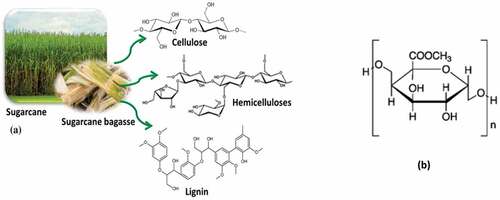
In contrast to cellulose, hemicellulose is a polysaccharide with a lower molecular weight. This amorphous, hydrophilic, heterogeneous, and heavily branched biomass accounts for around 30% of the total biomass weight. These serve as a bonding agent between hydrophilic cellulose and hydrophobic lignin & have a lesser degree of polymerization. Mannose, arabinose, methyl ether, and glucose are the residues of hemicellulose.
Lignin is a thermoplastic, amorphous polymer that is slightly friable at high temperatures. It has chemically related substances having a complex network of different molecular weights due to its aromatic nature. The structural rigidity of lignin is higher because the residues of hemicellulose are covalently bonded. Impermeability, tolerance to oxidative stress, and microbial attack are all benefits of its amorphous-heterogeneous existence. Alkyl-alkyl, alkyl-aryl, and aryl-aryl bonding can occur in lignin (Chen et al., Citation2017). The flexural modulus of bagasse fibre and biodegradable resin composites rose when the volume fraction of bagasse fibre was raised up to 65%. Fibre length and volume fraction of bagasse fibre can impact flexural modulus, flexural strength, and compression ratio (Shibata et al., Citation2005). Table illustrates the physical properties of sugarcane bagasse fibre.
Table 2. Physical properties of sugarcane bagasse fibre (Balaji et al., Citation2018)
3. Evaluation of Mechanical Properties of Bagasse Fibre Polymer Composite
3.1. Pre-Treatment of Bagasse Fibres
3.1.1. Alkali treatment
The mechanical property of the 1% NaOH solution-treated bagasse fibre composite showed improved mechanical properties (Cao et al., Citation2006). The enhancement occurred because of an increase in the strength and aspect ratio. Scanning electron microscopy (SEM) confirmed the increase in the fibre matrix adhesion (Onésippe et al., Citation2010). The thermal property of alkali-treated fibre in terms of macroscopic density and porosity determined the thermal conductivity of the fibres with alkali treatment. Table illustrates the Mechanical properties enhancement after alkali treatment.
Table 3. Mechanical properties enhancement after alkali treatment (Onésippe et al., Citation2010)
The outcome demonstrated that the specific heat of the bagasse fibres after alkali treatment had increased. Alkaline fibres have a lower heat conductivity than rectified fibres. The thermal conductivity of composites made with modified bagasse fibre is lower than that of composites made with an alkaline treatment. Alkaline treatment, known as mercerization, is one of the most used chemical processes for natural fibres used to strengthen thermoplastics and thermosets (Elmeniawy et al., Citation2021).
3.1.2. Effect of acrylic acid, mercerization, isocyanate and washing with an alkaline solution
Work was carried out by Vazquez A. et al. Citation1999 (Vázquez et al., Citation1999) processing of bagasse fibres polypropylene composites. To increase fibre adherence to the matrix, four distinct chemical treatments were used: acrylic acid, mercerization, isocyanate, and washing with an alkaline solution. Infrared spectroscopy was used to observe the effects of each chemical treatment. The infrared spectroscopy revealed that the mercerization process produces a heavily fibrillated surface. The impact of each chemical treatment on the composite’s tensile characteristics was investigated. The composite loses tensile strength and elongation at break when the fibres are not chemically treated. The tensile strength of the composite is improved by mercerization and isocyanate treatments. (Figure )
Figure 2. FTIR spectra of treated and untreated fibres a) isocyanate treatment b) acrylic acid treatment c) mercerization d) Mechanical properties of PP/bagasse composite with 20% of fibres (Vázquez et al., Citation1999).
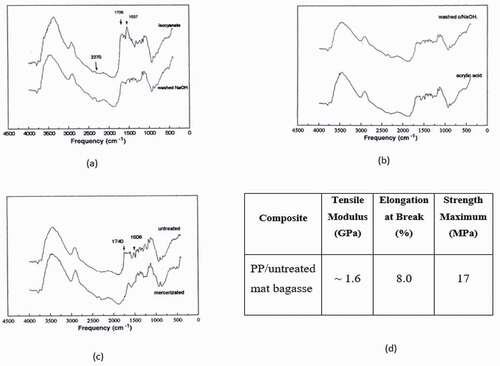
3.1.3. Effect of alkali and acid treatment
Another pre-treatment of bagasse fibre was carried out by Motaung et al. 2015 (T. E. Motaung & Anandjiwala, Citation2015) whereby sugarcane bagasse was washed with tap water, then rinsed in deionized water, and finally dried for a whole night at 50 degrees Celsius. When the pH was neutral, it was washed with deionized water and dried for the night at 50°C after being immersed for an hour at 80°C in a solution of 2% alkali. After being thoroughly cleaned with deionized water, it was pH-neutralized for 40 minutes at 80°C by submerging it in 5 per cent (v/v) sulfuric acid. As shown in Table , the highest concentration of hemicellulose was discovered in sugar cane bagasse that had not been treated, followed by samples that had been exposed to alkali, and samples that had been exposed to acid. The cellulose content of SB increased following alkali and acid treatments. Sulphuric acid-treated SB, on the other hand, had the greatest cellulose concentration, nearly 18% more than untreated SB. After acid treatment, the considerable shift in readings might suggest faster defibrillation of SB fibres.
Table 4. Sugar cane bagasse’s main components in fractions before and after exposure to alkali and acid (T. E. Motaung & Anandjiwala, Citation2015)
3.1.4. Maleic anhydride treatment (coupling agents)
A common agent for strengthening composites with fillers and reinforcements is maleic anhydride. A malleated coupling agent and mercerization treatment, change the surface and matrix to strengthen interfacial bonding. The process of this treatment may be explained by first activating the copolymer and then esterifying the cellulose (S. Mishra & Naik, Citation2005; Saber et al., Citation2023).
Mishra et al. 2003 worked on the Effect of Different Anhydrides on Cane Bagasse Pith and Melamine—Formaldehyde-Resin Composites (S. Mishra & Patil, Citation2003). Bagasse was treated with three different anhydrides: maleic, succinic, and phthalic & then reinforced with thermoset melamine-formaldehyde-resin. Promising results were seen in the mechanical properties of treated bagasse fibres. (Figure )
Figure 3. a) flexural characteristics of melamine-formaldehyde composites filled with cane bagasse pith and various anhydrides. b) Tensile strength of composite wood materials made using melamine-formaldehyde resin and cane bagasse pith (S. Mishra & Patil, Citation2003).
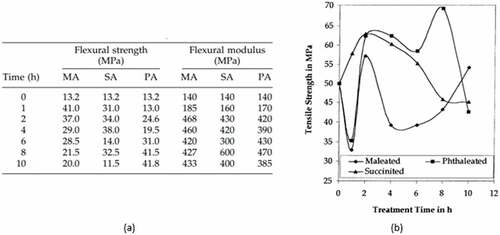
4. Thermosets Polymeric Composites:
4.1. Bagasse fibre/Phenolic resin composite
A comparative work was carried out between hybrid and pure composites and the tensile strength and tensile modulus of pure SCB/phenolic resin composites were evaluated and obtained value was 4.51 MPa and~470 MPa respectively (Table ). (Ramlee et al., Citation2019) There is poor interfacial bonding between pure SCB/Phenolic resin in comparison to hybrid composites. Hence the mechanical property values were supposed to be less than other hybrid composites due to the low density of single fibres.
Table 5. Mechanical Characteristics of a Composite of Bagasse and Phenolic Resin (Ramlee et al., Citation2019)
(Trindade et al., 2005) Another work was carried out where thermoset phenolic matrices reinforced with unmodified and surface-grafted furfuryl alcohol sugar cane bagasse fibres were studied. Bagasse fibre was oxidised before the final composites fabrication and it showed tensile strength up to 238 MPa and elongation of 0.9% (Table ). (Trindade et al., Citation2005)
Table 6. Tensile strength and elongation for untreated and treated sugar cane, expressed as a percentage (Trindade et al., Citation2005)
4.2. Bagasse/Jute hybrid reinforced epoxy composites
(Sudhir at el. 2014) Chemical alteration of jute and sugarcane bagasse fibers for an epoxy matrix was used by to generate novel hybrid composites (Table ) Such hybrid composites have superior mechanical characteristics than single matrix composites. The treated jute and bagasse taken in 1:1 ratio, resulted in better values of mechanical properties in comparison to untreated jute and bagasse fibres (Kumar Saw & Datta, Citation2009).
Table 7. Studies of Mechanical Behaviour of Enhanced JF Bundles Reinforced Epoxy Hybrid Composites Combined with Modified BF Bundles (Kumar Saw & Datta, Citation2009)
4.3. Bagasse fibre/Epoxy resin composites
Here the 5 % NaOH pre-treated Bagasse fibre was taken into consideration. The type of resin used was Araldite LY556 which was taken together with the hardener H×951. The usual hand lay-up process was used to process the composite (Kumar Acharya et al., Citation2011). A calculated amount of resin and the hardener was poured into the mould which is followed by a uniform distribution of bagasse fibre over the mixture. The required amount of pressure was applied and curing was done at room temperature for about 12 hours (P. Mishra & Acharya, Citation2010). As shown in Table , the flexural strength was evaluated for BF/Epoxy Resin’s flexural strength in different environment.
Table 8. BF/Epoxy Resins Flexural Strength in a different environment (P. Mishra & Acharya, Citation2010)
In the other case combination of bagasse fibre with oil palm fibre was rinsed and washed with hot water several times to remove the impurities. The fibre was used as filler and was uniformly mixed with Phenolic resin for 15 mins which were poured into a hot, pressing, moulding machine at 150 °C. Compression and curing of the composite specimen were done. Finally, the composite prepared was cold-pressed for 5 mins and the composite plates obtained were cut according to the ASTM standard.
The hybrid composite (7OPEFB:3SCB) has a better mechanical property which is due to the high cellulosic content. (Table ) The bagasse fibre has helped in reducing the water content and void (Ramlee et al., Citation2019).
Table 9. Mechanical characteristics of composites made of BF and epoxy with different fillers (Ramlee et al., Citation2019)
4.4. Bagasse-glass fibre/Epoxy resin composites
(Tewari et al., Citation2012) blended 15 weight %, 20 weight %, 25 weight %, and 30 weight % bagasse fibre with 5 weight % glass fibre in resin to generate a bagasse-glass fibre reinforced composite material. The maximum tensile strength is diminished when fibres made of bagasse are added. Glass fibre, however, improves ultimate tensile strength considerably more when contrasted to widely viable bagasse-based composites. Bagasse-glass reinforced fibres boost the impact strength of epoxy composites because they are more flexible than matrix materials. The capacity to absorb water is increased by the inclusion of fibres. This test is necessary when composites are used in damp environments. The bending toughness is impacted by the inclusion of bagasse fibre. The addition of glass fibre, however, increases the strength properties even more when compared to widely viable bagasse-based hybrids. (Table )
Table 10. Mechanical characteristics of composites made of bagasse, glass fibre, and epoxy resin (Tewari et al., Citation2012)
4.5. Bagasse fibre/Polyester composite
Bagasse fibre loading was done in several weight %’s, such as 20%, 30%, and 40%, with unsaturated polyester resin (UP). It was then treated with various concentrations of NaOH such as 0%, 20%, 30% and 40%. The results obtained show good enhancements in Modulus elasticity, Flexural modulus, Flexural strength and Tensile Strength of Bagasse Fibre reinforced polyester composites (Zakaria et al., Citation2020). (Figure )
Figure 4. a).The impact of various NaOH solution concentrations on the tensile strength of composites reinforced with unsaturated polyester and sugarcane fibre at various fibre loadings. b) the impact of various NaOH solution concentrations on the flexural modulus of unsaturated polyester composites reinforced with sugarcane fibres and various fibre loadings. c) the impact of various NaOH solution concentrations on the flexural strength of unsaturated polyester composites reinforced with sugarcane fibres and various fibre loadings. d) the impact of various NaOH solution concentrations on the elastic modulus of unsaturated polyester composites reinforced with sugarcane fibres and various fibre loadings (Zakaria et al., Citation2020).
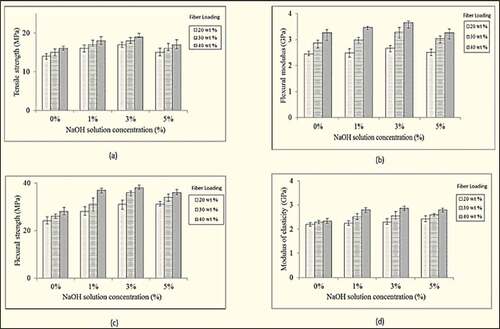
Similar work was carried out by (Vilay et al., Citation2008) There was another treatment of acrylic acid done on bagasse fibre before the final fabrication of composites. It shows when more fibre is added to the bagasse fibre–reinforced polyester composite, the tensile and flexural characteristics improve. (Figure ) shows treated fibre composites had better tensile and flexural characteristics than untreated fibre-based composites, with AA-treated fibre-based composites showing a significant trend.
Figure 5. The untreated and treated fibre composites’ (a) tensile strength (b) tensile modulus (c) flexural strength and (d) flexural modulus at various fibre loadings (Vilay et al., Citation2008).
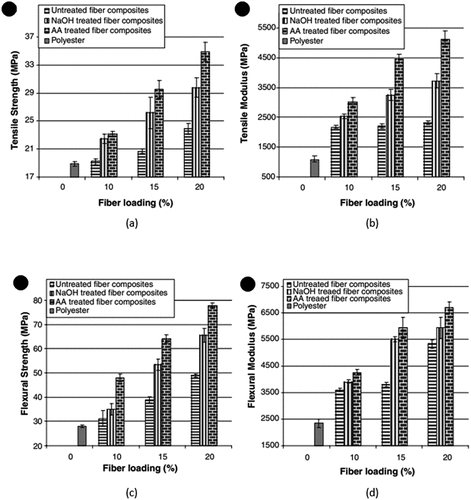
(Lee & Mariatti, Citation2008) carried out another work on unsaturated polyester composites using rind and pith components of bagasse fibre. The volume bagging method was used for the fabrication of such composites. For rind fibre composites, the flexural strength is raised by 127% (at 15% volume of fibre content), while for pith fibre composites, it increases by 70%. Similarly, for the flexural modulus, the rind fibre composites clearly showed an increasing trend as their fibre content rose. (Figure )
Figure 6. Unsaturated polyester composites reinforced with rind and pith fibres at various filler loadings were studied for their (a) flexural strength and (b) flexural modulus (Lee & Mariatti, Citation2008).
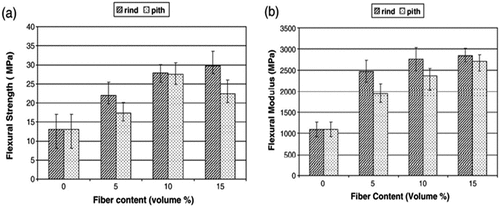
5. Thermoplastic Polymeric Composites
5.1. Bagasse fibre/Polypropylene composite
(Luz et al., Citation2007) carried out work on sugarcane bagasse fibres reinforced polypropylene composites in which combined 8.7–10 wt% bagasse and 6.7 wt% cellulose from bagasse with Polypropylene. The optimum moulding method is vacuum injection, which results in a uniform dispersion of fibres and eliminates blisters. The (Figure ) given below shows enhancement in the mechanical properties of fabricated composite using bagasse fibre. The amount of reinforcement applied had no effect on the tensile and flexural moduli variations. As Young’s modulus of fibres is larger than the thermoplastic modulus, their insertion can help to enhance the modulus.
Figure 7. A)tensile and Flexural Strength; b) Tensile and Flexural Modulus: Mechanical characteristics of composite materials (Luz et al., Citation2007).
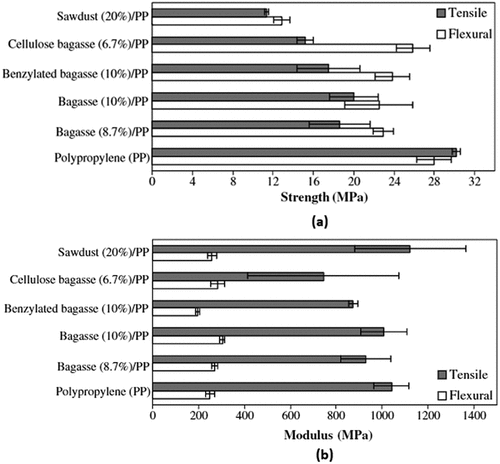
Another work on the similar composites was carried out by (Cerqueira et al., Citation2011) Bagasse fibre was pre-treated into 1% alkali solution and 10% sulphuric acid solution. Later these treated bagasse fibres were reinforced with polypropylene polymer. As the wt% of bagasse fibre increases from 5%, 10% and 20%, the mechanical properties also show an enhancement in fabricated polymer composite material. (Table )
Table 11. Mechanical properties of Bagasse Fibre/polypropylene composite (Cerqueira et al., Citation2011)
(T. E. Motaung et al., Citation2015) worked on silane-treated cane bagasse fibre reinforcing with recycled polypropylene. Injection moulding was used to prepare rPP/SB composite. In a mechanical study of that composite, it was found that there was a persistent increase in the modulus with an increase in the fibre content. Also, it was found that stress during break increased at the lowest SB concentration and then declined somewhat to a nearly constant value as SB content increased. (Figure ) A dispersion of the fibre and a significant interfacial adhesion might account for the first rise. The reported drop might be due to fibre end clustering and pull-outs. The rPP/SB composites’ elongation at break reduces as the SB content increases, however, the impact is less pronounced in the SB composite with the greatest concentration.
Figure 8. A)young’s modulus b) Stress and c) Elongation at break of rPP composites (T. E. Motaung et al., Citation2015).
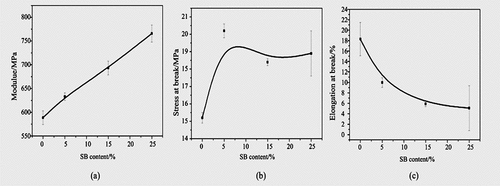
Development of another composite was reported using modified and unmodified bagasse fibre and recycled high-density polypropylene by (Carvalho Neto AGV et al., Citation2014) Injection moulding technique was used for the fabrication of the composite. The bagasse fibres went under different pre-treatments like mercerization and acetylation which is then referred to as modified bagasse fibre. A later comparison study was done on the mechanical properties of treated and untreated bagasse fibre reinforced with high-density polypropylene wt% of 5, 10 and 20. (Table )
Table 12. For recycled polyethene and various composites, the following properties have been studied: tensile strength, tensile modulus, flexural strength, flexural modulus, and Izod impact strength (Carvalho Neto AGV et al., Citation2014)
In another work (Lila et al., Citation2021) investigated the thermal post-processing of bagasse fibres-based polypropylene composites. Extrusion injection moulding has been used to create a polypropylene composite made from bagasse fibre with varying fibre weight fractions (10%, 20%, and 30%). The specimens were exposed for varying lengths of time to temperatures below their softening point. Tensile strength increased by 4.2 %, 7.6 %, 8.4 %, 9.0 %, 9.7 %, and 10.2 % during time periods of 15 minutes, 30 minutes, one hour, 3 hours, 4 hours, and 6 hours respectively, as compared to untreated specimens. In comparison to unexposed specimens, the increase in flexural strength was observed to be 6.2 %, 9.08 %, 13.93 %, 14.19 %, 16.90 %, and 17.76 % longer thermal post-processing times. In contrast, the increase in flexural modulus was observed to be 17.67 % and 21.97 % longer thermal post-processing times (Lila et al., Citation2021).
5.2. Bagasse fibre/Polystyrene Composites
Sugarcane bagasse fibre was first modified with dichloro-methyl vinyl silane and grafted using polystyrene. The grafted bagasse with polystyrene showed higher thermal stability (examined through TGA) than those of untreated fibre. This showed a significant increase in young’s modulus but there was a slight loss in the tensile strength. The effective improvement in the mechanical property is due to the better interfacial adhesion between the fibres and the polymer matrix.
The PS composite of bagasse was prepared by in-situ polymerization and the mechanical properties like tensile strength, Flexural strength and wear rate was measured for different size varying from 75 µm to 350 µm (Table ). (AB et al., Citation2013)
Table 13. Composites made of polystyrene and bagasse fibre’s mechanical characteristics (AB et al., Citation2013)
In conclusion, as the mechanical property of PS-SFB increases, it also depends on the filler size. For the alkali pre-treatment, sugarcane bagasse was submerged in NaCl solution, and the resin was made by swirling polystyrene with Methylethylketone at the ratios of 60:40, 70:30, and 80:20 for about 1 hour. The bagasse fibre (short fibre Granule) and polystyrene solvent were mixed and dried in a 70°C oven for 15 minutes. The composite was prepared using the hot press process (AB et al., Citation2013). The results were clear that the binding strength and compressive strength were increased with decreasing the bagasse fibre (short fibre Granule). (Tables –Table )
Table 14. ~tc~
Table 15. ~tc~
5.3. Bagasse fibre/Polyethylene Composites
At 160°C, 30 revolutions per minute, and 12 minutes, the HDPE-SFB was made using the melt-mixed process over a roll mill. According to the TGA investigation, the composites are much less thermally stable than the polymer matrix separately. Due to enhanced interfacial adhesion between both the fibre and the polymer matrix, the ultimate tensile and modulus were increased while the elongation at break & the impact strength was decreased (El-Fattah et al., Citation2015).
In an extruder screw, sugarcane bagasse was combined with HDPE polymer matrix. The fibre composition was taken as 10%. The temperature set for 4 different zones were 120°C, 130°C, 140°C, and 150°C and the screw speed rate was 50RPM. They are later compressed in moulds for mechanical testing. There was no improvement in the elongation break and the tensile strength but there was an improvement in the tensile modulus. (Tables )
Table 16. Mechanical properties of Bagasse/Polyethylene Composites (Mulinari, Voorwald, Cioffi, DASILVA, et al., Citation2009)
Table 17. Mechanical characteristics of materials produced by compression moulding (Mulinari, Voorwald, Cioffi, DASILVA, et al., Citation2009)
Another composite was made by using low-density polyethylene and bagasse fibre by (T. Motaung et al., Citation2017). Before fabrication with melt compounding methods, bagasse fibre was treated mechanically by passing it through a 1 mm. sieve and then kept in deionised water for 24 hours. Bagasse fibre was passed through the sieves at different numbers of times (100, 200 and 500 times). Then composite was developed using mechanically treated fibres in 95/5 as LDPE/SB and its mechanical properties were studied. (Table )
Table 18. Mechanical results of pure LDPE and its composites (T. Motaung et al., Citation2017)
Similar work was carried out by (Moubarik et al., Citation2013) using low-density polyethene but native Moroccan sugarcane cellulose fibre. Before the fabrication of the composite by Screw Extruder Method, it was pre-treated in 3 steps with hot water, alkali, and bleaching. After fabrication mechanical properties of composites were tested containing 10%, 15%, 20% and 25% of bagasse fibre in composites.
In another work by (Mulinari, Voorwald, Cioffi, da Silva, et al., Citation2009) they fabricated composite using injection moulding and described the mechanical and morphological characteristics of composites made of high-density polyethene, processed sugarcane bagasse cellulose, and reform leftovers. In comparison to untreated bagasse cellulose, the zirconium oxychloride modification of bagasse cellulose with HDPE demonstrated greater tensile strength. (Figure ) Because the modified cellulose has better fibre-to-matrix adhesion and tensile strength than the original cellulose does, it has been demonstrated that zirconium oxychloride modification of cellulose enhances that adherence.
Figure 9. A)the mechanical characteristics of the materials produced by injection moulding. b) the percentage of elongation at break for composite specimens (Mulinari, Voorwald, Cioffi, da Silva, et al., Citation2009).
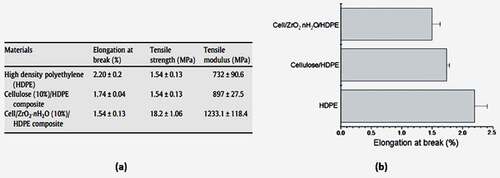
5.4. Bagasse fibre/PLA Composites
(Nampitch et al., Citation2016) worked on to create composite PLA/bagasse fibre foams with varying fibre contents of 0%, 5%, 10%, 15%, and 20% wt percent and a fixed foaming agent with an additional 2 wt % added for all composites. Investigations were conducted into the shape and mechanical characteristics of clean PLA and PLA/bagasse fibre composite foams. Tensile testing revealed that whereas plain PLA had a tensile strength of 25.63 MPa, the greatest fibre content at 7 wt % was 45.27 MPa. Impact strength showed a tendency to decline as fibre content rose. (Figure )
Figure 10. a) the tensile strength and Young’s modulus of PLA foams that were either neat or composited with varied amounts of bagasse fibre. b) Izod impact resistance of pure PLA and PLA/bagasse fibre composite foams with varying bagasse fibre contents (Nampitch et al., Citation2016).
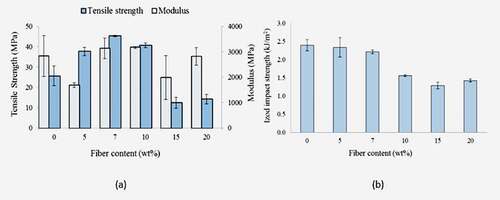
5.5. Bagasse fibre/PVC Composites
Compression moulding was used to create the pre-treated PVC composite with benzoic acid. For around 7 minutes, two roll mills were used to compound the BF and PVC. The temperature was held between 150 and 170 degrees Celsius. The matrix was first created, then the fibre was put to it upon reaching a stable plastifying condition (which will take almost 3 mins). In order to create specimens that may be utilised for evaluating mechanical properties, it is mixed for an additional 3–4 minutes before being put into a compression mould (Zheng et al., Citation2007). Two varieties of specimens were prepared; the dog-shaped specimen was used for the tensile testing and the rectangular shape was used for the Impact test (Kokta et al., Citation1990).
The result reached was that benzoic acid is an excellent adhesion promoter for BF/PVC composites, increasing the dispersion of BF in the PVC matrix (as evidenced by SEM analysis) and thereby increasing the composite’s tensile strength (Kokta et al., Citation1990). (Table )
Table 19. Mechanical characteristics of composites made of bagasse and PVC (Zheng et al., Citation2007)
The BF/PVC composites can also be prepared using the virgin polyvinyl chloride by the Screw Extruder Method. The BF/PVC composite here was prepared using 41.2%, 50%, 2%, 6%, and 0.8% by wt. of PVC, Bagasse, Lubricant, & heat stabilisers. The mechanical properties were studied at different temperatures (Xu et al., Citation2010). (Table )
Table 20. Variation in Mechanical properties on Increasing temperature for BF/PVC composite (Xu et al., Citation2010)
The temperature showed a large effect on the creep activity of the composite. At low temperatures, the creep resistance showed was compared to the high stress-strain behaviour and the 30 min creep data was collected.
Another work of bagasse/PVC composite was carried out by (Huang et al., Citation2012) where Mechanical activation (MA) and surface modification of sugarcane bagasse (SCB) were carried out utilizing a self-designed stirring ball mill and aluminate coupling agent, (ACA) respectively. SCBs were used to create composites with a matrix material of polyvinyl chloride, both unmodified and differentially treated (PVC). After being compounded with PVC, the mechanical properties of both unaltered and ACA-modified SCB (40-weight % of SCB and PVC matrix) were examined. (Figure )
Figure 11. a) the impact of milling time on the unaltered SCB/PVC composites’ flexural and tensile strengths. b) Flexural strength and tensile strength of ACA-modified SCB/PVC composites as a function of milling time (Huang et al., Citation2012).
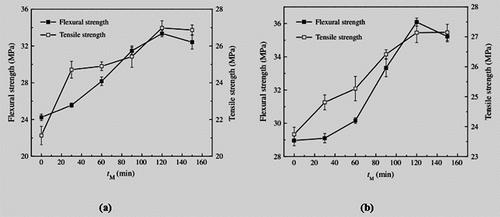
6. Elastomer Polymeric Composites
6.1. Carbonized bagasse filler/natural rubber composites
The objects were put through a variety of tests, including those for tensile strength, compression test, abrasion resistance, hardness, and elongation at break. As the filler loading grew, so did the material’s tensile strength, abrasion resistance, and hardness properties. Reduced filler loading also enhanced properties such as elongation at break and compression set. As a result, in Figure the bagasse filler seems to be reinforcing in nature and has intrinsic reinforcing potential. This is because when more filler is introduced into the rubber matrix, the rubber chain’s flexibility is diminished, resulting in a stiffer vulcanizate (Osarenmwinda & Abode, Citation2010).
Figure 12. a) effect of filler loading on compression set b) effect of filler loading on tensile strength c) effect of filler loading on elongation at break d) effect of filler loading on hardness (Osarenmwinda & Abode, Citation2010).
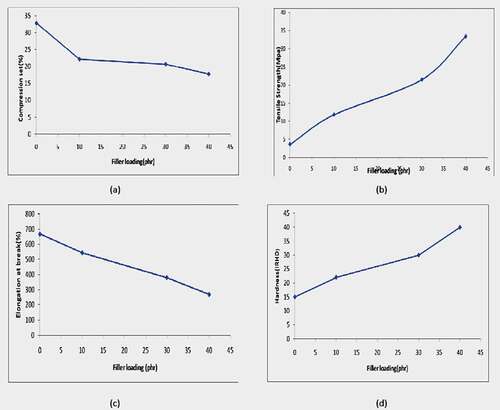
6.2. Bagasse fibre/Starch Composite
Starch-based matrix and bagasse fibres were used to create environmentally friendly, biodegradable “green” composites by (Mehanny et al., Citation2012). Native corn starch was emulsified with glycerin and water before being applied to bagasse fibres that had already been processed and treated with NaOH. The composite was warmed before being pressed at 5 MPa and 170°C for 30 minutes. SEM revealed strong adhesion between fibres and matrix, with up to 60% of fibres adhering to the matrix. As the fibre weight percentage climbed from 0% to 60%, the tensile and flexural strengths improved as well. (Figure )
Figure 13. a) Experimental and theoretical tensile strength of composite with different fibre weight content. b) Flexural strength of composite with different fibre weight content (Mehanny et al., Citation2012).
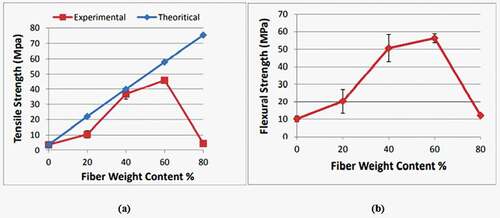
7. Applications
Sugarcane bagasse fibre was widely available, making it easy to employ as a natural fibre and reinforcing polymer in a variety of applications. The hydrophilic character may affect the overall property but proper chemical modifications can overcome this limitation. The thermal degradation behaviour will be altered while the thermal and mechanical characteristics will be improved. The studies on the usage of bagasse as a filler material in composites showed the betterment of such mechanical properties. The aging studies on the bagasse composites showed that the bagasse ash as a binder in concrete gave an improvement in the thermal stability of the concrete at elevated temperatures (Table ).
Table 21. Application of Sugarcane bagasse fibre reinforced composites in different sectors
8. Conclusion
This review concludes with the different composites prepared from thermosets, thermoplastic, and elastomers polymers reinforcing with sugarcane bagasse fibre. Also, study of the mechanical properties of the different composites has been carried out in comparison with the polymer matrix alone. This is due to the better interfacial adhesion between the fibres and polymer matrix. The size of the filler material is responsible for its thermal and mechanical properties. Loading of up to 20% will improve the mechanical properties of the composite material. Reinforcement of sugarcane bagasse fibre with different polymers leads to enhancements in their mechanical properties such as Tensile strength (MPa), Tensile modulus (MPa), Flexural strength (MPa), Flexural modulus (MPa). Natural fibre Composites can be prime examples of sustainable materials and sustainable development with more emphasis giving on fabrication of novel materials, causing lesser pollution to the environment. Due to the large pool of examples of polymers, there are still some unexplored composites to be fabricated using bagasse depending on suitable mechanical properties. If all the limitations are addressed using appropriate polymers and natural fibres, along with further research into the surface chemical modification, and mechanical properties, then improvements pertaining to current composites can be made and successfully implemented in an environmental friendly way. Composites with natural materials have gained popularity in machine implementations, leading manufacturers to explore their potential in reducing waste and associated carbon costs. These composites, which incorporate agricultural fibres to reinforce thermoplastics, are particularly appealing to the vehicle manufacturing sector for producing lightweight, cost-effective, and strong automobile interiors. This approach not only upgrades fuel efficiency but also addresses the public’s demand for eco-friendly vehicles. Natural Fibres composites as biomaterials in field of packaging still trending topic for many researchers to explore it further.
Acknowledgments
The authors thankfully acknowledge Manipal Academy of Higher Education, Manipal, India for providing funding to support open access publication of this article.
Disclosure statement
No potential conflict of interest was reported by the authors.
Additional information
Notes on contributors
Mohd. Khalid Zafeer
Mohd Khalid Zafeer completed his post-graduation in Analytical Chemistry from Aligarh Muslim University, Aligarh (2019-2021). Ms. Roopa Prabhu completed her post-graduation in Chemistry from Manipal Academy of Higher Education (2019-2021). Ms. Sithara Rao doing her post-graduation in Chemistry from Manipal Academy of Higher Education (2021-2023). Dr. Bhat works as an Additional Professor in the Department of Chemistry, Manipal Institute of Technology, Manipal, India. His research interests include synthetic chemistry and, Physics and Chemistry of Materials. He authored about 70 research papers, two patents, and co-edited a book on nanocomposites. G T Mahesha, presently Professor in the department of Aeronautical and Automobile Engineering. His research interests focused on development of natural fibre composites and their applications.
References
- AB, A. M. M., Liyana, J., Norazian, M. N., Kamarudin, H., & Ruzaidi, C. M. (2013). Mechanical properties of polymer composites with sugarcane bagasse filler. Advanced Materials Research, 740, 739–22. https://doi.org/10.4028/www.scientific.net/AMR.740.739
- Ali, H. T., Alghtani, A. H., Felemban, B. F., Abd El-Aziz, K., Saber, D., Ahmed, E. M., Megahed, M., & Fotouhi, M. (2021). Multivariable analysis for selection of natural fibers as fillers for a sustainable food packaging industry. Materials Research Express, 8(9), 095504. https://doi.org/10.1088/2053-1591/ac17a9
- Alokika, A., Kumar, A., Kumar, A., Kumar, V., & Singh, B. (2021). Cellulosic and hemicellulosic fractions of sugarcane bagasse: Potential, challenges and future perspective. International Journal of Biological Macromolecules, 169, 564–582. https://doi.org/10.1016/j.ijbiomac.2020.12.175
- Balaji, A., Karthikeyan, B., Swaminathan, J., & Sundar Raj, C. (2018). Thermal behavior of cardanol resin reinforced 20 mm long untreated bagasse fiber composites. International Journal of Polymer Analysis and Characterization, 23(1), 70–77. https://doi.org/10.1080/1023666X.2017.1387448
- Bin Bakri, M. K., Rahman, M. R., & Matin, M. M. (2022). Cellulose reinforcement in thermoset composites. In Fundamentals and Recent Advances in Nanocomposites Based on Polymers and Nanocellulose (pp. 127–142). Elsevier. https://doi.org/10.1016/B978-0-323-85771-0.00011-7
- Boparai K, S., & Kumar, A. (2021). Thermosetting polymer composites. Encyclopedia of Materials: Plastics and Polymers, 1, 584–587. https://doi.org/10.1016/B978-0-12-820352-1.00102-4
- Brabazon, D. (2021). Introduction: Polymer Matrix Composite Materials. In Encyclopedia of Materials: Composites (pp. 563–564). Elsevier. https://doi.org/10.1016/B978-0-12-819724-0.00109-9
- Cao, Y., Shibata, S., & Fukumoto, I. (2006). Mechanical properties of biodegradable composites reinforced with bagasse fibre before and after alkali treatments. Composites Part A Applied Science and Manufacturing, 37(3), 423–429. https://doi.org/10.1016/j.compositesa.2005.05.045
- Carvalho Neto AGV, D., Ganzerli, T. A., Cardozo, A. L., Fávaro, S. L., Pereira, A. G. B., Girotto, E. M., & Radovanovic, E. (2014). Development of composites based on recycled polyethylene/sugarcane bagasse fibers. Polymer Composites, 35(4), 768–774. https://doi.org/10.1002/pc.22720
- Cerqueira, E. F., CARP, B., & Mulinari, D. R. (2011). Mechanical behaviour of polypropylene reinforced sugarcane bagasse fibers composites. Procedia Engineering, 10, 2046–2051. https://doi.org/10.1016/j.proeng.2011.04.339
- Chandramohan, D. (2014). Studies on natural fiber particle reinforced composite material for conservation of natural resources. Advances in Applied Science Research, 5(2), 305–315.
- Chen, M. J., Li, R. M., Zhang, X. Q., Feng, J., Feng, J., Liu, C. -F., & Shi, Q. -S. (2017). Homogeneous transesterification of sugar cane bagasse toward sustainable plastics. ACS Sustainable Chemistry & Engineering, 5(1), 360–366. https://doi.org/10.1021/acssuschemeng.6b01735
- Da Silva, C. G., & Frollini, E. (2020). Unburned sugarcane bagasse: bio-based phenolic thermoset composites as an alternative for the management of this agrowaste. Journal of Polymers and the Environment, 28(12), 3201–3210. https://doi.org/10.1007/s10924-020-01848-y
- Devadiga, D. G., Bhat, K. S., Mahesha, G., & Sánchez, J. (2020). Sugarcane bagasse fiber reinforced composites: Recent advances and applications. Cogent Engineering, 7(1), 1823159. https://doi.org/10.1080/23311916.2020.1823159
- Díaz-Ramírez, G., Maradei, F., & Vargas-Linares, G. (2019). Bagasse sugarcane fibers as reinforcement agents for natural composites: Description and polymer composite applications. Revista UIS Ingenierías, 18(4), 117–130. https://doi.org/10.18273/revuin.v18n4-2019011
- Dinesh, S., Kumaran, P., Mohanamurugan, S., Vijay, R., Singaravelu, D. L., Vinod, A., Sanjay, M. R., Siengchin, S., & Bhat, K. S. (2020). Influence of wood dust fillers on the mechanical, thermal, water absorption and biodegradation characteristics of jute fiber epoxy composites. Journal of Polymer Research, 27(1), 9. https://doi.org/10.1007/s10965-019-1975-2
- El-Fattah, A. A., el Demerdash, A. G. M., Alim Sadik, W. A., & Bedir, A. (2015). The effect of sugarcane bagasse fiber on the properties of recycled high density polyethylene. Journal of Composite Materials, 49(26), 3251–3262. https://doi.org/10.1177/0021998314561484
- Elmeniawy, M., Mansour, A., Hamdy, A., & Saber, D. (2021). Mechanical properties and corrosion behavior of sugarcane Bagasse fiber reinforced low density polyethylene composites. The Egyptian International Journal of Engineering Sciences and Technology, 36(2), 63–71. https://doi.org/10.21608/eijest.2021.80884.1072
- Huang, Z., Wang, N., Zhang, Y., Hu, H., & Luo, Y. (2012). Effect of mechanical activation pretreatment on the properties of sugarcane bagasse/poly(vinyl chloride) composites. Composites Part A Applied Science and Manufacturing, 43(1), 114–120. https://doi.org/10.1016/j.compositesa.2011.09.025
- Ilczyszyn, F., Cherouat, A., & Montay, G. (2014). Effect of hemp fibre morphology on the mechanical properties of vegetal fibre composite material. Advanced Materials Research, 875-877, 485–489. https://doi.org/10.4028/www.scientific.net/AMR.875-877.485
- Islam, S., Islam, S., & Hasan, M. (2022). Natural fiber reinforced polymer composites as sustainable green composites. In Encyclopedia of Materials: Plastics and Polymers (pp. 987–996). Elsevier. https://doi.org/10.1016/B978-0-12-820352-1.00257-1
- John, M. J., & Anandjiwala, R. D. (2008). Recent developments in chemical modification and characterization of natural fiber-reinforced composites. Polymer Composites, 29(2), 187–207. https://doi.org/10.1002/pc.20461
- Kokta, B. V., Maldas, D., Daneault, C., & Béland, P. (1990). Composites of poly(vinyl chloride) and wood fibers. Part II: Effect of chemical treatment. Polymer Composites, 11(2), 84–89. https://doi.org/10.1002/pc.750110203
- Kumar Acharya, S., Mishra, P., & Kumar Mehar, S. (2011). Effect of surface treatment on the mechanical properties of bagasse fiber reinforced polymer composite. Bioresources, 6, 3155–3165. https://doi.org/10.15376/biores.6.3.3155-3165
- Kumar, S., Manna, A., & Dang, R. (2022). A review on applications of natural Fiber-Reinforced composites (NFRCs). Materials Today: Proceedings, 50, 1632–1636. https://doi.org/10.1016/j.matpr.2021.09.131
- Kumar Saw, S., & Datta, C. (2009). Thermomechanical properties of jute/bagasse hybrid fibre reinforced epoxy thermoset composites. Bioresources, 4, 1455–1476. https://doi.org/10.15376/BIORES.4.4.1455-1475
- Ku, H., Wang, H., Pattarachaiyakoop, N., & Trada, M. (2011). A review on the tensile properties of natural fiber reinforced polymer composites. Composites Part B: Engineering, 42(4), 856–873. https://doi.org/10.1016/j.compositesb.2011.01.010
- Lee, S. C., & Mariatti, M. (2008). The effect of bagasse fibers obtained (from rind and pith component) on the properties of unsaturated polyester composites. Materials Letters, 62(15), 2253–2256. https://doi.org/10.1016/j.matlet.2007.11.097
- Lila, M. K., Komal, U. K., & Singh, I. (2021). Thermal post-processing of bagasse fiber reinforced polypropylene composites. Composites Communications, 23, 100546. https://doi.org/10.1016/j.coco.2020.100546
- Lodha, P., & Netravali, A. N. (2005). Characterization of stearic acid modified soy protein isolate resin and ramie fiber reinforced ‘green’ composites. Composites Science and Technology, 65(7–8), 1211–1225. https://doi.org/10.1016/j.compscitech.2004.12.036
- Luz, S. M., Gonçalves, A. R., & Del’arco, A. P. (2007). Mechanical behavior and microstructural analysis of sugarcane bagasse fibers reinforced polypropylene composites. Composites Part A Applied Science and Manufacturing, 38(6), 1455–1461. https://doi.org/10.1016/j.compositesa.2007.01.014
- Mehanny, S., Farag, M., Rashad, R. M., Elsayed, H. (2012) Fabrication and characterization of starch based bagasse fiber composite. In: International Conference of Mechanical Engineering (IMECHE2012). ASME, Texas, USA
- Mishra, P., & Acharya, S. K. (2010). Anisotropy abrasive wear behavior of bagasse fiber reinforced polymer composite. International Journal of Engineering Science and Technology, 2(11), 104–112. https://doi.org/10.4314/ijest.v2i11.64558
- Mishra, S., & Naik, J. B. (2005). Effect of treatment of maleic anhydride on mechanical properties of natural fiber: Polystyrene composites. Polymer-Plastics Technology and Engineering, 44(4), 663–675. https://doi.org/10.1081/PTE-200057814
- Mishra, S., & Patil, Y. P. (2003). Compatibilizing effect of different anhydrides on cane bagasse pith and melamine–formaldehyde-resin composites. Journal of Applied Polymer Science, 88(7), 1768–1774. https://doi.org/10.1002/app.12207
- Motaung, T. E., & Anandjiwala, R. D. (2015). Effect of alkali and acid treatment on thermal degradation kinetics of sugar cane bagasse. Industrial Crops and Products, 74, 472–477. https://doi.org/10.1016/j.indcrop.2015.05.062
- Motaung, T. E., Linganiso, L. Z., John, M., & Anandjiwala, R. D. (2015). The effect of silane treated sugar cane bagasse on mechanical, thermal and crystallization studies of recycled polypropylene. Materials Sciences and Applications, 06(08), 724–733. https://doi.org/10.4236/msa.2015.68074
- Motaung, T., Mochane, M., Makhetha, T., Motloung, S., Mokhothu, T., Mokhena, T., & Moji, R. (2017). Effect of mechanical treatment on morphology and thermal and mechanical properties of sugar cane bagasse–low-density polyethylene composites. Polymer Composites, 38(8), 1497–1503. https://doi.org/10.1002/pc.23717
- Motsoeneng, T. S., Magagula, S., & Mohapi, M.et al.(2021). Elastomer matrix based natural fiber composites. Fibre Reinforced Composites: Constituents, Compatibility, Perspectives, and Applications. Elsevierpp. 167–185. https://doi.org/10.1016/B978-0-12-821090-1.00013-2.
- Moubarik, A., Grimi, N., & Boussetta, N. (2013). Structural and thermal characterization of Moroccan sugar cane bagasse cellulose fibers and their applications as a reinforcing agent in low density polyethylene. Composites Part B: Engineering, 52, 233–238. https://doi.org/10.1016/j.compositesb.2013.04.040
- Mulinari, D. R., Voorwald, H. J. C., Cioffi, M. O. H., DASILVA, M., DACRUZ, T., & SARON, C. (2009). Sugarcane bagasse cellulose/HDPE composites obtained by extrusion. Composites Science and Technology, 69(2), 214–219. https://doi.org/10.1016/J.COMPSCITECH.2008.10.006
- Mulinari, D. R., Voorwald, H. J. C., Cioffi, M. O. H., da Silva, M. L. C. P., & Luz, S. M. (2009). Preparation and properties of HDPE/sugarcane bagasse cellulose composites obtained for thermokinetic mixer. Carbohydrate Polymers, 75(2), 317–321. https://doi.org/10.1016/j.carbpol.2008.07.028
- Nampitch, T., Wiphanurat, C., Kaisone, T., & Hanthanon, P. (2016). Mechanical and Morphological Properties of Poly(Lactic Acid)/Bagasse Fiber Composite Foams. Applied Mechanics and Materials, 851, 31–36. https://doi.org/10.4028/www.scientific.net/amm.851.31
- O’Donnell, A., Dweib, M. A., & Wool, R. P. (2004). Natural fiber composites with plant oil-based resin. Composites Science and Technology, 64(9), 1135–1145. https://doi.org/10.1016/j.compscitech.2003.09.024
- Onésippe, C., Passe-Coutrin, N., Toro, F., Delvasto, S., Bilba, K., & Arsène, M. -A. (2010). Sugarcane bagasse fibres reinforced cement composites: Thermal considerations. Composites Part A Applied Science and Manufacturing, 41(4), 549–556. https://doi.org/10.1016/j.compositesa.2010.01.002
- Osarenmwinda, J. O., & Abode, S. I. (2010). Potential of Carbonized Bagasse Filler in Rubber Products. Journal of Emerging Trends in Engineering and Applied Sciences, 1, 2141–7016. https://hdl.handle.net/10520/EJC136062
- Panthapulakkal, S., Raghunanan, L., & Sain, M. et al. (2017). Natural fiber and hybrid fiber thermoplastic composites: Advancements in lightweighting applications. Green Composites: Waste and Nature-based Materials for a Sustainable Future. Second. Elsevier Incpp. 39–72. https://doi.org/10.1016/B978-0-08-100783-9.00003-4.
- Panwar, V., & Pal, K. (2022). Recent Developments of Thermosetting Polymers for Advanced Composites. Encyclopedia of Materials: Plastics and Polymers, 2, 1047–1056. https://doi.org/10.1016/B978-0-12-820352-1.00268-6
- Parameswaran, B., Raveendran, S., & Pandey, A. (2021). Introduction to biodegradable polymers and composites: Process engineering to commercialization. Biomass, Biofuels, Biochemicals, 3–10. https://doi.org/10.1016/B978-0-12-821888-4.00014-9
- Patil, R., & Kalagi, G. (2015). The mechanical properties of natural fibre reinforced polymer composites: A Review. International Journal of Engineering Research & Technology, 3, 17. https://doi.org/10.17577/IJERTCONV3IS17059
- Pervaiz, M., Panthapulakkal, S., KC, B., Sain, M., & Tjong, J. (2016). Emerging trends in automotive lightweighting through novel composite materials. Materials Sciences and Applications, 07(01), 26–38. https://doi.org/10.4236/msa.2016.71004
- Potiron, C. O., Passe-Coutrin, N., & Toro, F., et al. (2010). Sugarcane bagasse fibres reinforced cement composites: Thermal considerations. Composites Part A Applied Science and Manufacturing, 41, 549–556. https://doi.org/10.1016/j.compositesa.2010.01.002
- Prabhu, R., Ganesh, S., Mahesha, G., Bhat, K. S., & Sánchez, J. (2022). Physicochemical characteristics of chemically treated bagasse fibers. Cogent Engineering, 9(1), 2014025. https://doi.org/10.1080/23311916.2021.2014025
- Ramlee, N. A., Jawaid, M., Zainudin, E. S., & Yamani, S. A. K. (2019). Tensile, physical and morphological properties of oil palm empty fruit bunch/sugarcane bagasse fibre reinforced phenolic hybrid composites. Journal of Materials Research and Technology, 8(4), 3466–3474. https://doi.org/10.1016/j.jmrt.2019.06.016
- Saber, D., & Abdelnaby, A. H. (2022). Recent developments in natural fiber as reinforcement in polymeric composites: A Review. Asian Journal of Applied Science and Technology, 06(03), 56–75. https://doi.org/10.38177/ajast.2022.6308
- Saber, D., Abdelnaby, A. H., & Abdelhaleim, A. M. (2023). Fabrication of ecofriendly composites using low-density polyethylene and sugarcane bagasse: Characteristics’ degradation. Textile Research Journal, 004051752311612. https://doi.org/10.1177/00405175231161281
- Saber, D., & El-Aziz K, A. (2022). Advanced materials used in wearable health care devices and medical textiles in the battle against coronavirus (COVID-19): A review. Journal of Industrial Textiles, 51(1_suppl), 246S–271S. https://doi.org/10.1177/15280837211041771
- Saheb, D. N., & Jog, J. P. (1999). Natural fiber polymer composites: A review. Advances in Polymer Technology, 18, 351–363. doi:https://doi.org/10.1002/(SICI)1098-2329(199924)18:4<351:AID-ADV6>3.0.CO;2-X
- Sanjay, M. R., Arpitha, G. R., Naik, L. L., Gopalakrishna, K., & Yogesha, B. (2016). Applications of Natural Fibers and Its Composites: An Overview. Natural Resources, 07(03), 108–114. https://doi.org/10.4236/nr.2016.73011
- Shibata, S., Cao, Y., & Fukumoto, I. (2005). Effect of bagasse fiber on the flexural properties of biodegradable composites. Polymer Composites, 26(5), 689–694. https://doi.org/10.1002/pc.20140
- Singh, A. A., Afrin, S., & Karim, Z. (2017). Green Composites: Versatile Material for Future. In M. Jawaid, M. Salit, & O. Alothman (Eds.), Green Biocomposites. Green Energy and Technology. Springer. https://doi.org/10.1007/978-3-319-49382-4_2
- Teixeira, R. S., Tonoli, G. H. D., Santos, S. F., Fiorelli, J., Savastano, H., & Lahr, F. A. R. (2012). Extruded cement based composites reinforced with sugar cane bagasse fibres. Key Engineering Materials, 517, 450–457. https://doi.org/10.4028/www.scientific.net/KEM.517.450
- Tewari, M., Singh, V. K., Gope, P. C., & Chaudhary, A. K. (2012). Evaluation of mechanical properties of bagasse-glass fiber reinforced composite Composite. J Mater Environ Sci, 3, 171–184.
- Tezara, C., Siregar, J. P., & Lim, H. Y., et al. (2016). Factors that affect the mechanical properties of kenaf fiber reinforced polymer: A review. Journal of Mechanical Engineering and Sciences, 10, 2159–2175. https://doi.org/10.15282/jmes.10.2.2016.19.0203
- Thakur, V. K., & Thakur, M. K. (2014). Processing and characterization of natural cellulose fibers/thermoset polymer composites. Carbohydrate Polymers, 109, 102–117. https://doi.org/10.1016/J.CARBPOL.2014.03.039
- Thomas, S., Joseph, K., Malhotra, S. K., Goda, K., & Sreekala, M. S. (Eds.). (2012). Polymer composites, macro-and microcomposites (Vol. 1). John Wiley & Sons. https://doi.org/10.1002/9783527674220
- Trindade, W. G., Hoareau, W., & Megiatto, J. D., et al. (2005). Thermoset phenolic matrices reinforced with unmodified and surface-grafted furfuryl alcohol sugar cane bagasse and curaua fibers: properties of fibers and composites. Biomacromolecules, 6, 2485–2496. https://doi.org/10.1021/bm058006
- Vázquez, A., Domínguez, V. A., & Kenny, J. M. (1999). Bagasse fiber-polypropylene based composites. Journal of Thermoplastic Composite Materials, 12(6), 477–497. https://doi.org/10.1177/089270579901200604
- Vidyashri, V., Lewis, H., Narayanasamy, P., Mahesha, G. T., & Bhat, K. S. (2019). Preparation of chemically treated sugarcane bagasse fiber reinforced epoxy composites and their characterization. Cogent Engineering, 6(1), 1708644. https://doi.org/10.1080/23311916.2019.1708644
- Vilay, V., Mariatti, M., Mat Taib, R., & Todo, M. (2008). Effect of fiber surface treatment and fiber loading on the properties of bagasse fiber–reinforced unsaturated polyester composites. Composites Science and Technology, 68(3–4), 631–638. https://doi.org/10.1016/j.compscitech.2007.10.005
- Xu, Y., Wu, Q., Lei, Y., & Yao, F. (2010). Creep behavior of bagasse fiber reinforced polymer composites. Bioresource Technology, 101(9), 3280–3286. https://doi.org/10.1016/j.biortech.2009.12.072
- Yashas Gowda, T. G., Sanjay, M. R., Subrahmanya Bhat, K., Madhu, P., Senthamaraikannan, P., Yogesha, B., & Pham, D. (2018). Duc Pham (Reviewing Editor) (2018) Polymer matrix-natural fiber composites: An overview. Cogent Engineering, 5(1), 1. https://doi.org/10.1080/23311916.2018.1446667
- Zakaria, M. S., Musa, L., Nordin, R. M., & Halim, K. A. A. (2020). Sugarcane Bagasse Reinforced Polyester Composites: Effects of Fiber Surface Treatment and Fiber Loading on the Tensile and Flexural Properties. IOP Conference Series: Materials Science and Engineering, 957(1), 012032. https://doi.org/10.1088/1757-899X/957/1/012032
- Zheng, Y. T., Cao, D. R., Wang, D. S., & Chen, J. J. (2007). Study on the interface modification of bagasse fibre and the mechanical properties of its composite with PVC. Composites Part A Applied Science and Manufacturing, 38(1), 20–25. https://doi.org/10.1016/j.compositesa.2006.01.023
